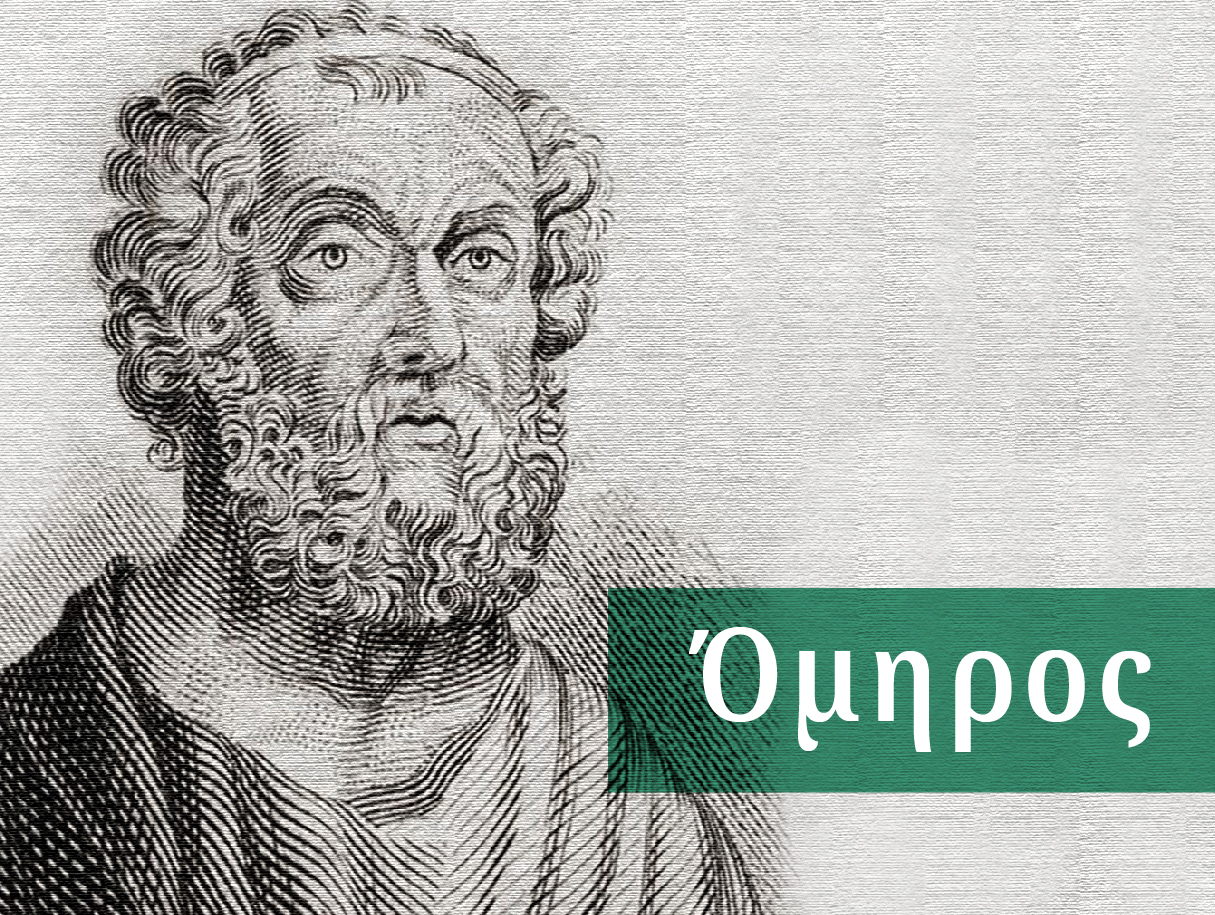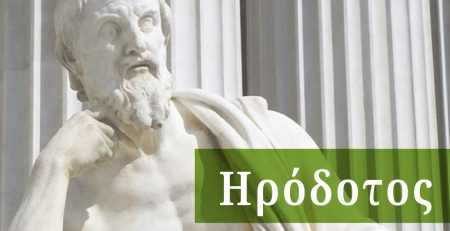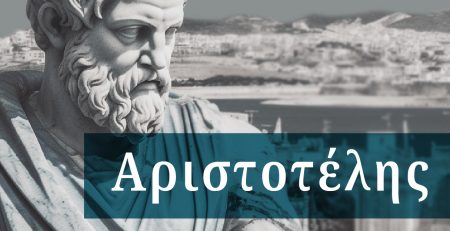Homer, the Homeric epics, and their influence on ancient Greek literature
The antagonism about his place of birth
There is uncertainty about the birthplace and time of Homer. In fact, many modern philologists even question his existence. Krates of Mallos estimates that Homer lived sixty years after the Trojan War, while Eratosthenes places Homer’s peak a hundred years after the Trojan War and twenty after the descent of the Heracleidae. Thucydides, on the other hand, believes that Homer lived “much later than the Trojan War.”
According to tradition, Homer hailed from Ionia. However, according to legend, it is estimated that cities from all over Greece claimed his origin, specifically: Pylos, Argos, Athens, and the predominant Smyrna and Chios.
The etymologies surrounding the name of Homer
The Homeric dialect
Homeric poetry is usually placed in the post-Mycenaean years, in the first millennium BCE. Chronologically, within Homeric poetry, three major dialect groups had formed: the Aeolic, the Attic-Ionic, and the Western Greek, with a fourth smaller one, limited to central Peloponnese and Cyprus, known as Arcado-Cypriot.
As seen in the Iliad and the Odyssey, the dialect used by Homer consists of mixed, primarily Ionic and Aeolic, dialectical forms. It is an artificial language that does not represent any specific dialect of a particular region or a specific time period, while the linguistic standards in the texts of the ancient epic poet retain older characteristics.
This mixed dialect, known as the Homeric dialect, served as a literary model for epic and didactic poets who followed, such as Hesiod, and later for lyric poetry. Various literary languages and genres were thus influenced by Homer, regardless of the origin of the poets who represented them.
The Homeric epics and their timeless value

The Homeric Question
Iliad: a tale of wrath, gods, and heroes
The Iliad, though closely linked to Achilles and his story, is not named “Achilleis” but draws its title from the city of Ilium (Troy), around which the Trojan War unfolds.
The Iliad consists of 15,693 verses written in dactylic hexameter in an artistic poetic language, and its composition is placed around the 8th century BCE. It is divided into 24 rhapsodies, each corresponding to a capital letter of the Greek alphabet (Α-Ω). This system existed already in the time of Herodotus.
The epic refers to a glorified past full of heroic deeds, at the end of the Mycenaean period.
Iliad – summary

The Odyssey: a tale of nostos and adventure
Odyssey – summary

Epic Cycle or Epic Poems
The name indicates the epics, written almost all between 800 and 500 BCE, which have as their subject the events related to the Trojan War. They are ‘supplementary’ to the Homeric epics, as they narrate events that either precede or follow, or relate to specific episodes of the Trojan War.
The works included in the epic cycle unfortunately survive in fragments. Indeed, for some of them, we only know the titles. Thanks to these, we know the ‘complete’ story of the Trojan War. Indeed, the fall of Troy through the Trojan Horse is known to us through these works, as it is not included in the Iliad (as many wrongly believe).
The epic or Trojan cycle constitutes the literary expression of the Heroic Age of ancient times, and closes together with it. The Epic Cycle includes:
- Cypria: Narrates the events preceding the Iliad, in eleven books. It starts with Zeus’ desire to provoke a great war to limit overpopulation on earth. It follows the story of the marriage of Achilles’ parents, the judgment of Paris, the abduction of beautiful Helen, the gathering of the Greeks in Aulis, and the first ten years of the campaign.
- Aethiopis: Narrates the last exploits of Achilles, including his duel with the Amazon Penthesilea, his death, and burial.
- Little Iliad: From the death of Achilles to the construction of the Trojan Horse.
- Sack of Troy: The fall of Troy and the savagery of the Achaeans, which led to their punishment by the gods.
- Returns: The story of the Achaeans’ return to their homelands.
- Telegony: The last years of Odysseus after his return to Ithaca, up to his death at the hands of his son Telegonus.”
Homeric Hymns
Tradition has handed down, along with the Iliad and the Odyssey, 34 hymns under the name of the great epic poet. However, their origin is difficult to ascertain.Η χειρόγραφη παράδοση έδωσε, μαζί με την Ιλιάδα και την Οδύσσεια, 34 ύμνους με το όνομα του μεγάλου επικού ποιητή. Ωστόσο η προέλευσή τους είναι δύσκολο να εξακριβωθεί.
The Homeric Hymns are written in dactylic hexameter, imitating the style of the epic verses, and often borrow typical Homeric expressions verbatim. The first reference to them in written texts was made by Thucydides. They vary in length, as some are brief and complete in three to four lines, while others have up to five hundred.
Today’s researchers consider them to be works later than Homer, composed probably in the 7th or 6th century BCE. Some of the hymns are even considered works of the Hellenistic Period.
In any case, the Homeric Hymns are a distinct sample of a rich literary tradition and, together, a source for the customs of a very distant era. They follow a standardized format, beginning with an invocation to the deity being hymned, mentioning their genealogy and attributes, and ending with a salutation or prayer, often announcing another related hymn to be recited next.
It is important to note that the Homeric hymns are not religious hymns. They maintain the heroic character of the epics, drawing their subject matter from the stories of the gods or, in some cases, other heroes
Homer and Hesiod
If Homer is the oldest source for the lives of great mythological heroes, Hesiod is the oldest and most complete source for the myths concerning the ancient pantheon. With the Theogony, Hesiod depicted the birth of the gods from the era of Chaos to the triumph of the Olympian gods through the Titanomachy. With the poem Works and Days, Hesiod gave us a detailed picture of rural life in his time.
Were Homer and Hesiod contemporaries? And if so, did they ever meet?
Αν ο Όμηρος είναι η αρχαιότερη πηγή μας για τη ζωή σπουδαίων μυθολογικών ηρώων, ο Ησίοδος είναι η αρχαιότερη και πληρέστερη πηγή μας για τους μύθους που αφορούν το αρχαίο πάνθεον. Με την Θεογονία, ο Ησίοδος αποτύπωσε την γένεση των θεών από την εποχή του Χάους ως την επικράτηση των θεών του Ολύμπου μέσα από την Τιτανομαχία. Με το ποίημα Έργα και Ημέραι, ο Ησίοδος μας χάρισε μια λεπτομερή εικόνα της αγροτικής ζωής της εποχής του.
This is a question that still doesn’t have a convincing answer today. However, there is an (anonymous) ancient work that recounts a legendary poetry contest between them.
According to this, Homer and Hesiod meet in Chalkis, at the funeral games for King Amphidamas, which include a poetic competition. In this competition, each poet is called upon to complete the verses of the other. Homer leads the entire competition, and the crowd believes he will be the winner. However, in the end, Panedes, the brother of the deceased king, awards the prize to Hesiod because his verses are about rural life and peace, rather than war and slaughter.
It is likely that we will never know if such a contest actually took place between the two great poets. The Contest of Homer and Hesiod, however, is an ode to Homer: The great poet may not be crowned the winner of the contest, but his poetry is described as superior to that of Hesiod, proving that Homer’s greatness was recognized very early on.
The Trojan War in the Tragic Poets of Classical Antiquity
The Trojan Cycle, whether we are talking about the Iliad and the Odyssey or the other epic cycles, was a source of inspiration for the Attic drama of classical Athens. Both the three major tragedians and lesser-known playwrights, whose works have not survived, wrote about the Trojan War.
Beyond the themes, the Homeric works also influenced the language of the great tragedians, and in some plays, such as Euripides’ Phoenician Women, there are scenes that strongly resemble scenes from the Homeric epics.
Aeschylus and the Homeric language
Perhaps the most striking drama inspired by the epic cycles is Aeschylus’s Agamemnon. Aeschylus is considered to have been influenced by Homer to such an extent that Aristophanes made him confess in “The Frogs” that he was inspired by Homer for his most heroic characters.
“Agamemnon,” the first part of a trilogy completed by The Choephori and The Eumenides, remains one of the most frequently performed tragedies to this day. It narrates the return of Agamemnon to Argos, along with Cassandra, who recounts the sufferings of the Atreides and predicts the death of the warlord himself, as well as her own, at the hands of Clytemnestra, who has not forgotten that Agamemnon sacrificed their daughter, Iphigenia, to launch the Achaean fleet.
Euripides: the tragedian of the Atreides
Events before and after the Trojan War inspired some of Euripides’ most significant works:
- Iphigenia in Aulis: The fleet of the Achaeans is stranded in Aulis, waiting for a favorable wind to sail to Troy. Agamemnon summons his daughter Iphigenia from Mycenae to sacrifice her, pretending that she will be married to Achilles. The young girl offers herself for sacrifice for the sake of her homeland. Euripides also wrote Iphigenia in Tauris, which narrates the fate of Iphigenia when Artemis saves her from the sacrifice and transports her to her sanctuary in Tauris.
- Rhesus: The plot unfolds in Troy, during the Trojan War. It is a dramatization of Book K of the Iliad.
- Troades: The play follows the fate of the women of Troy after the city’s fall and the brutal plunder by the Achaeans. Similar themes are explored in The Phoenician Women, the tragedy of the aged queen of Troy who seeks revenge for the death of her sons Polyxena and Polydorus. Also relevant is Andromache, a work that narrates the life of Hector’s wife after the fall of Troy, when she is given as booty to Achilles’ son Neoptolemus.
- Helen: In this particular tragedy, Euripides argues that Helen never actually went to Troy, but Paris took an image of her to the city.
- Cyclops: Euripides’ only surviving satirical drama. The Satyrs, led by Silenus, serve the Cyclops. Odysseus blinds the Cyclops, saving his companions and the Satyrs.
Sophocles, the “Homer of Tragedy”
The post-Homeric discourses: “The Continuation of Homer” in the Hellenistic era
The Homeric Problems by Heraclitus
Heraclitus (1st century CE, not the philosopher Heraclitus of Ephesus) in a collection of allegories with 79 chapters, followed the sequence of the rhapsodies of the Homeric epics, seeking their allegorical content. This work is known as the Homeric Problems.
Heraclitus interpreted the Homeric epics as allegories that provide answers to issues of physics, ethics, astronomy, history, etc. Similar attempts were made by the Pythagoreans and Neoplatonists, who attempted a mystical interpretation of the Homeric work. However, there is no reference in Heraclitus’ work to the interpretation of the Neoplatonists, so it seems he was not familiar with their work, perhaps because he predates them.
Heraclitus’ aim was to highlight the infallibility of Homer. He considered him the proponent of all fundamental philosophical doctrines on matters of ethics, history, and even science. For example, interpreting the myth of the construction of Achilles’ shield, he argued that Homer had conceived the universe as a large sphere with the Earth as a smaller sphere located at the center of the world. He also believed that Homer knew about the harmony of the spheres and the exact dates of eclipses.
Thus, Heraclitus regarded Homer as more than just a great poet. In his work, he praised him and countered his critics, especially Plato and Epicurus.





